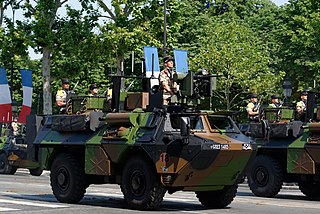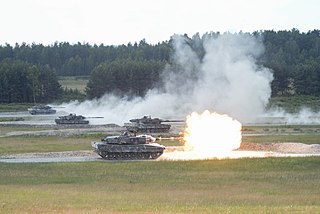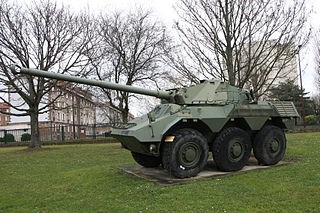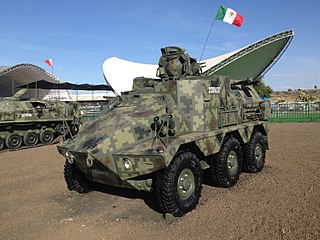Related Research Articles

An armoured fighting vehicle or armored fighting vehicle (AFV) is an armed combat vehicle protected by armour, generally combining operational mobility with offensive and defensive capabilities. AFVs can be wheeled or tracked. Examples of AFVs are tanks, armoured cars, assault guns, self-propelled artilleries, infantry fighting vehicles (IFV), and armoured personnel carriers (APC).

The Véhicule de l'Avant Blindé or VAB is a French armoured personnel carrier and support vehicle designed and manufactured by Renault Trucks Defense. It entered service in 1976 and around 5,000 were produced. It has seen combat in various conflicts in Africa, Asia as well as Europe and has also been exported to more than 15 countries.

Arena or Kazt, is an active protection system (APS) developed at Russia's Kolomna-based Engineering Design Bureau for the purpose of protecting armoured fighting vehicles from destruction by light anti-tank weapons, anti-tank guided missiles (ATGM), and flyover top attack missiles. It uses a Doppler radar to detect incoming warheads. Upon detection, a defensive rocket is fired that detonates near the inbound threat, destroying it before it hits the vehicle.

The Combat Vehicle Reconnaissance (Tracked), abbreviated CVR(T), is a family of armoured fighting vehicles (AFVs) developed in the 1960s and is in service with the British Army and others throughout the world. They are small, highly mobile, air-transportable armoured vehicles, originally designed to replace the Alvis Saladin armoured car.

The FV101 Scorpion is a British armoured reconnaissance vehicle, and also a light tank. It was the lead vehicle and the fire support type in the Combat Vehicle Reconnaissance (Tracked), CVR(T), family of seven armoured vehicles. Manufactured by Alvis, it was introduced into service with the British Army in 1973 and was withdrawn in 1994. More than 3,000 were produced and used as a reconnaissance vehicle or a light tank.

Armoured warfare or armored warfare, is the use of armoured fighting vehicles in modern warfare. It is a major component of modern methods of war. The premise of armoured warfare rests on the ability of troops to penetrate conventional defensive lines through use of manoeuvre by armoured units.

The Ferret armoured car, also commonly called the Ferret scout car, is a British armoured fighting vehicle designed and built for reconnaissance purposes. The Ferret was produced between 1952 and 1971 by the UK company Daimler. It was widely used by regiments in the British Army, as well as the RAF Regiment and Commonwealth countries throughout the period.

The Renault VBC-90 is a six-wheeled French armoured car carrying a 90mm high-velocity gun mated to a sophisticated fire control computer and ranging system. It was developed primarily for internal security or armed reconnaissance purposes. Modeled after Renault's Véhicule de l'Avant Blindé (VAB) armoured personnel carrier, the VBC-90 was engineered in concert with Saviem and Creusot-Loire. One was also built in prototype form by Argentina under license, where it was known as the Vehículos de Apoyo y Exploración. VBC-90s were available with various chassis configurations resembling both the VAB and the Berliet VXB-170.

The ASCOD armoured fighting vehicle family is the product of a cooperation agreement between Austrian Steyr-Daimler-Puch AG and Spanish General Dynamics Santa Bárbara Sistemas. The ASCOD family includes the LT 105, a light tank equipped with a 105 mm gun, a surface-to-air missile launcher, an anti-tank guided missile launcher, mortar carrier, R&R vehicle, command and control vehicle, ambulance, artillery observer, and the AIFV model. In Spanish service, the vehicle is called "Pizarro", while the Austrian version is called "Ulan".

The Bravia Chaimite is an armored vehicle with all wheel drive axles built by the Portuguese company Bravia and used by the Portuguese Army in the Portuguese colonial wars in Angola, Mozambique and Portuguese Guinea, from 1967 to 1974 when it ended. The Chaimite was originally an unlicensed derivative of the Cadillac Gage Commando assembled and later produced in Portugal, with a number of improvements and technical modifications.

The 85-mm divisional gun D-44 was a Soviet divisional 85-mm calibre field artillery gun used in the last action of World War II. It was designed as the replacement for the 76 mm divisional gun M1942 (ZiS-3). The gun is no longer in front-line service with the Russian Ground Forces, although some 200 of the Chinese Type 56 variant are still in service with the Pakistan Army. Wartime service included use by communist forces during the Vietnam War and by Arab forces during their conflicts with Israel.

The Type 85 is a tracked armoured fighting vehicle produced by Chinese company Norinco. It is an improved version of the Type 63 armoured personnel carrier. The vehicle is bigger, has additional firing ports and periscopes, a longer chassis with an additional road wheel on each side, and is equipped with an NBC protection system.

The Walid is an Egyptian wheeled armored personnel carrier based on the BTR-40. It was built by the Kader Factory for Developed Industries. It entered production in 1960 and was first deployed by the Egyptian Army during the Six-Day War.

The Panhard VCR is a light armored personnel carrier (APC) designed by Panhard for the export market and later used by several countries. After Iraq ordered French turrets in September 1974 capable of launching antitank guided missiles (ATGM), the Panhard VCR was developed at the request of the Iraqis for vehicles with which to mate these ATGM-launcher turrets. This resulted in the largest order of VCRs, 100, for Iraq.

The WZ-523 is a six-wheeled Chinese armored personnel carrier designed to be amphibious. Built on the chassis of the Hanyang HY472 truck, it can carry a crew of three and seat up to eight additional passengers. Two primary models were produced—one with a roof-mounted 12.7mm heavy machine gun, and the other with a small turret armed with a 35mm grenade launcher and a 7.62mm co-axial general purpose machine gun. An export model that entered service in 2008 as a fire support vehicle was also marketed successfully to the Namibian Army; this is armed with a 73mm 2A28 Grom smoothbore cannon in exactly the same turret as used on the Soviet BMP-1 infantry fighting vehicle.

The T17 Armoured Car, sometimes referred to as the M5 medium armoured car and by the British as the Deerhound, was an American six-wheeled armored car produced during the Second World War.

The 105×617mm, also known as 105×617mmR, is a common, NATO-standard, tank gun cartridge used in 105mm guns such as those derived from the Royal Ordnance L7.

An unditching beam is a device that is used to aid in the recovery of armoured fighting vehicles when they become bogged or "ditched". The device is a beam that is attached to the continuous tracks that provides additional traction for the vehicle to extricate itself from a ditch or from boggy conditions.
References
- ↑ "Christopher F Foss", IHS Jane's Armoured Fighting Vehicles, defenceiq.com, retrieved November 1, 2020
- ↑ Foss, Christopher F(rank) 1946-, encyclopedia.com, retrieved November 1, 2020
- ↑ Virtual International Authority File: Catalog, Christopher F. Foss